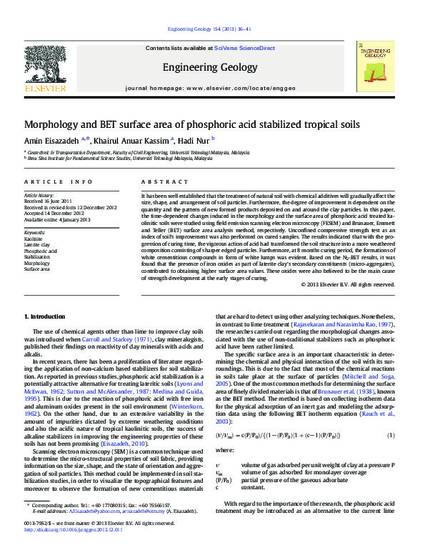
Article
Morphology and BET surface area of phosphoric acid stabilized tropical soils
Engineering Geology
(2013)
Abstract
It has been well established that the treatment of natural soil with chemical additives will gradually affect the size, shape, and arrangement of soil particles. Furthermore, the degree of improvement is dependent on the quantity and the pattern of new formed products deposited on and around the clay particles. In this paper, the time-dependent changes induced in the morphology and the surface area of phosphoric acid treated kaolinitic soils were studied using field emission scanning electron microscopy (FESEM) and Brunauer, Emmett and Teller (BET) surface area analysis method, respectively. Unconfined compressive strength test as an index of soil's improvement was also performed on cured samples. The results indicated that with the progression of curing time, the vigorous action of acid had transformed the soil structure into a more weathered composition consisting of sharper edged particles. Furthermore, at 8 months curing period, the formations of white cementitious compounds in form of white lumps was evident. Based on the N2-BET results, it was found that the presence of iron oxides as part of laterite clay's secondary constituents (micro-aggregates), contributed to obtaining higher surface area values. These oxides were also believed to be the main cause of strength development at the early stages of curing.
Keywords
- Kaolinite,
- Laterite clay,
- Phosphoric acid Stabilization,
- Morphology,
- Surface area
Disciplines
Publication Date
2013
DOI
10.1016/j.enggeo.2012.12.011
Citation Information
Amin Eisazadeh, Khairul Anuar Kassim and Hadi Nur. "Morphology and BET surface area of phosphoric acid stabilized tropical soils" Engineering Geology Vol. 154 (2013) p. 36 - 41 Available at: http://works.bepress.com/hadi_nur/95/
